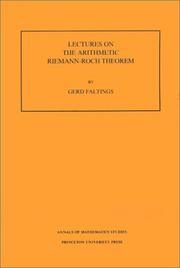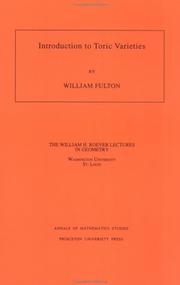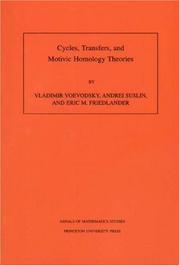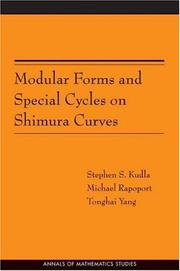| Listing 1 - 5 of 5 |
Sort by
|

ISBN: 0691087717 0691025444 1400882478 Year: 2016 Volume: vol 127 Publisher: Princeton, NJ : Princeton University Press,
Abstract | Keywords | Export | Availability | Bookmark
 Loading...
Loading...Choose an application
- Reference Manager
- EndNote
- RefWorks (Direct export to RefWorks)
The arithmetic Riemann-Roch Theorem has been shown recently by Bismut-Gillet-Soul. The proof mixes algebra, arithmetic, and analysis. The purpose of this book is to give a concise introduction to the necessary techniques, and to present a simplified and extended version of the proof. It should enable mathematicians with a background in arithmetic algebraic geometry to understand some basic techniques in the rapidly evolving field of Arakelov-theory.
Algebraic geometry --- Algebraïsche meetkunde --- Geometry [Algebraic ] --- Géométrie algébrique --- Meetkunde [Algebraïsche ] --- Riemann-Roch theorema's --- Riemann-Roch thoerems --- Theoremes de Riemann-Roch --- Geometry, Algebraic. --- Riemann-Roch theorems. --- Theorems, Riemann-Roch --- Algebraic functions --- Geometry, Algebraic --- Geometry --- Addition. --- Adjoint. --- Alexander Grothendieck. --- Algebraic geometry. --- Analytic torsion. --- Arakelov theory. --- Asymptote. --- Asymptotic expansion. --- Asymptotic formula. --- Big O notation. --- Cartesian coordinate system. --- Characteristic class. --- Chern class. --- Chow group. --- Closed immersion. --- Codimension. --- Coherent sheaf. --- Cohomology. --- Combination. --- Commutator. --- Computation. --- Covariant derivative. --- Curvature. --- Derivative. --- Determinant. --- Diagonal. --- Differentiable manifold. --- Differential form. --- Dimension (vector space). --- Divisor. --- Domain of a function. --- Dual basis. --- E6 (mathematics). --- Eigenvalues and eigenvectors. --- Embedding. --- Endomorphism. --- Exact sequence. --- Exponential function. --- Generic point. --- Heat kernel. --- Injective function. --- Intersection theory. --- K-group. --- Levi-Civita connection. --- Line bundle. --- Linear algebra. --- Local coordinates. --- Mathematical induction. --- Morphism. --- Natural number. --- Neighbourhood (mathematics). --- Parameter. --- Projective space. --- Pullback (category theory). --- Pullback (differential geometry). --- Pullback. --- Riemannian manifold. --- Riemann–Roch theorem. --- Self-adjoint operator. --- Smoothness. --- Sobolev space. --- Stochastic calculus. --- Summation. --- Supertrace. --- Theorem. --- Transition function. --- Upper half-plane. --- Vector bundle. --- Volume form.

ISBN: 0691000492 0691033323 1400882524 Year: 1993 Publisher: Princeton Princeton university press
Abstract | Keywords | Export | Availability | Bookmark
 Loading...
Loading...Choose an application
- Reference Manager
- EndNote
- RefWorks (Direct export to RefWorks)
Toric varieties are algebraic varieties arising from elementary geometric and combinatorial objects such as convex polytopes in Euclidean space with vertices on lattice points. Since many algebraic geometry notions such as singularities, birational maps, cycles, homology, intersection theory, and Riemann-Roch translate into simple facts about polytopes, toric varieties provide a marvelous source of examples in algebraic geometry. In the other direction, general facts from algebraic geometry have implications for such polytopes, such as to the problem of the number of lattice points they contain. In spite of the fact that toric varieties are very special in the spectrum of all algebraic varieties, they provide a remarkably useful testing ground for general theories. The aim of this mini-course is to develop the foundations of the study of toric varieties, with examples, and describe some of these relations and applications. The text concludes with Stanley's theorem characterizing the numbers of simplicies in each dimension in a convex simplicial polytope. Although some general theorems are "ed without proof, the concrete interpretations via simplicial geometry should make the text accessible to beginners in algebraic geometry.
Algebraic geometry --- Differential geometry. Global analysis --- 512.7 --- Algebraic geometry. Commutative rings and algebras --- Toric varieties. --- 512.7 Algebraic geometry. Commutative rings and algebras --- Toric varieties --- Embeddings, Torus --- Torus embeddings --- Varieties, Toric --- Algebraic varieties --- Addition. --- Affine plane. --- Affine space. --- Affine variety. --- Alexander Grothendieck. --- Alexander duality. --- Algebraic curve. --- Algebraic group. --- Atiyah–Singer index theorem. --- Automorphism. --- Betti number. --- Big O notation. --- Characteristic class. --- Chern class. --- Chow group. --- Codimension. --- Cohomology. --- Combinatorics. --- Commutative property. --- Complete intersection. --- Convex polytope. --- Convex set. --- Coprime integers. --- Cotangent space. --- Dedekind sum. --- Dimension (vector space). --- Dimension. --- Direct proof. --- Discrete valuation ring. --- Discrete valuation. --- Disjoint union. --- Divisor (algebraic geometry). --- Divisor. --- Dual basis. --- Dual space. --- Equation. --- Equivalence class. --- Equivariant K-theory. --- Euler characteristic. --- Exact sequence. --- Explicit formula. --- Facet (geometry). --- Fundamental group. --- Graded ring. --- Grassmannian. --- H-vector. --- Hirzebruch surface. --- Hodge theory. --- Homogeneous coordinates. --- Homomorphism. --- Hypersurface. --- Intersection theory. --- Invertible matrix. --- Invertible sheaf. --- Isoperimetric inequality. --- Lattice (group). --- Leray spectral sequence. --- Limit point. --- Line bundle. --- Line segment. --- Linear subspace. --- Local ring. --- Mathematical induction. --- Mixed volume. --- Moduli space. --- Moment map. --- Monotonic function. --- Natural number. --- Newton polygon. --- Open set. --- Picard group. --- Pick's theorem. --- Polytope. --- Projective space. --- Quadric. --- Quotient space (topology). --- Regular sequence. --- Relative interior. --- Resolution of singularities. --- Restriction (mathematics). --- Resultant. --- Riemann–Roch theorem. --- Serre duality. --- Sign (mathematics). --- Simplex. --- Simplicial complex. --- Simultaneous equations. --- Spectral sequence. --- Subgroup. --- Subset. --- Summation. --- Surjective function. --- Tangent bundle. --- Theorem. --- Topology. --- Toric variety. --- Unit disk. --- Vector space. --- Weil conjecture. --- Zariski topology.

ISBN: 0691048142 0691048150 9786613379825 1283379821 140083712X 9780691048147 9780691048154 Year: 2011 Volume: 143 Publisher: Princeton, NJ : Princeton University Press,
Abstract | Keywords | Export | Availability | Bookmark
 Loading...
Loading...Choose an application
- Reference Manager
- EndNote
- RefWorks (Direct export to RefWorks)
The original goal that ultimately led to this volume was the construction of "motivic cohomology theory," whose existence was conjectured by A. Beilinson and S. Lichtenbaum. This is achieved in the book's fourth paper, using results of the other papers whose additional role is to contribute to our understanding of various properties of algebraic cycles. The material presented provides the foundations for the recent proof of the celebrated "Milnor Conjecture" by Vladimir Voevodsky. The theory of sheaves of relative cycles is developed in the first paper of this volume. The theory of presheaves with transfers and more specifically homotopy invariant presheaves with transfers is the main theme of the second paper. The Friedlander-Lawson moving lemma for families of algebraic cycles appears in the third paper in which a bivariant theory called bivariant cycle cohomology is constructed. The fifth and last paper in the volume gives a proof of the fact that bivariant cycle cohomology groups are canonically isomorphic (in appropriate cases) to Bloch's higher Chow groups, thereby providing a link between the authors' theory and Bloch's original approach to motivic (co-)homology.
Bundeltheorie --- Cohomology [Sheaf ] --- Faisceaux [Théorie des ] --- Sheaf cohomology --- Sheaf theory --- Sheaves (Algebraic topology) --- Sheaves [Theory of ] --- Théorie des faisceaux --- Algebraic cycles --- Homology theory --- Algebraic cycles. --- Homology theory. --- Cohomology theory --- Contrahomology theory --- Algebraic topology --- Cycles, Algebraic --- Geometry, Algebraic --- Abelian category. --- Abelian group. --- Addition. --- Additive category. --- Adjoint functors. --- Affine space. --- Affine variety. --- Alexander Grothendieck. --- Algebraic K-theory. --- Algebraic cycle. --- Algebraically closed field. --- Andrei Suslin. --- Associative property. --- Base change. --- Category of abelian groups. --- Chain complex. --- Chow group. --- Closed immersion. --- Codimension. --- Coefficient. --- Cohomology. --- Cokernel. --- Commutative property. --- Commutative ring. --- Compactification (mathematics). --- Comparison theorem. --- Computation. --- Connected component (graph theory). --- Connected space. --- Corollary. --- Diagram (category theory). --- Dimension. --- Discrete valuation ring. --- Disjoint union. --- Divisor. --- Embedding. --- Endomorphism. --- Epimorphism. --- Exact sequence. --- Existential quantification. --- Field of fractions. --- Functor. --- Generic point. --- Geometry. --- Grothendieck topology. --- Homeomorphism. --- Homogeneous coordinates. --- Homology (mathematics). --- Homomorphism. --- Homotopy category. --- Homotopy. --- Injective sheaf. --- Irreducible component. --- K-theory. --- Mathematical induction. --- Mayer–Vietoris sequence. --- Milnor K-theory. --- Monoid. --- Monoidal category. --- Monomorphism. --- Morphism of schemes. --- Morphism. --- Motivic cohomology. --- Natural transformation. --- Nisnevich topology. --- Noetherian. --- Open set. --- Pairing. --- Perfect field. --- Permutation. --- Picard group. --- Presheaf (category theory). --- Projective space. --- Projective variety. --- Proper morphism. --- Quasi-projective variety. --- Residue field. --- Resolution of singularities. --- Scientific notation. --- Sheaf (mathematics). --- Simplicial complex. --- Simplicial set. --- Singular homology. --- Smooth scheme. --- Spectral sequence. --- Subcategory. --- Subgroup. --- Summation. --- Support (mathematics). --- Tensor product. --- Theorem. --- Topology. --- Triangulated category. --- Type theory. --- Universal coefficient theorem. --- Variable (mathematics). --- Vector bundle. --- Vladimir Voevodsky. --- Zariski topology. --- Zariski's main theorem. --- 512.73 --- 512.73 Cohomology theory of algebraic varieties and schemes --- Cohomology theory of algebraic varieties and schemes

ISBN: 0691120439 0691120447 1299133258 1400837170 9780691120430 9781400837175 9780691120447 Year: 2004 Volume: no. 157 Publisher: Princeton Princeton University Press
Abstract | Keywords | Export | Availability | Bookmark
 Loading...
Loading...Choose an application
- Reference Manager
- EndNote
- RefWorks (Direct export to RefWorks)
In recent years, considerable progress has been made in studying algebraic cycles using infinitesimal methods. These methods have usually been applied to Hodge-theoretic constructions such as the cycle class and the Abel-Jacobi map. Substantial advances have also occurred in the infinitesimal theory for subvarieties of a given smooth variety, centered around the normal bundle and the obstructions coming from the normal bundle's first cohomology group. Here, Mark Green and Phillip Griffiths set forth the initial stages of an infinitesimal theory for algebraic cycles. The book aims in part to understand the geometric basis and the limitations of Spencer Bloch's beautiful formula for the tangent space to Chow groups. Bloch's formula is motivated by algebraic K-theory and involves differentials over Q. The theory developed here is characterized by the appearance of arithmetic considerations even in the local infinitesimal theory of algebraic cycles. The map from the tangent space to the Hilbert scheme to the tangent space to algebraic cycles passes through a variant of an interesting construction in commutative algebra due to Angéniol and Lejeune-Jalabert. The link between the theory given here and Bloch's formula arises from an interpretation of the Cousin flasque resolution of differentials over Q as the tangent sequence to the Gersten resolution in algebraic K-theory. The case of 0-cycles on a surface is used for illustrative purposes to avoid undue technical complications.
512.73 --- Cohomology theory of algebraic varieties and schemes --- 512.73 Cohomology theory of algebraic varieties and schemes --- Algebraic cycles. --- Hodge theory. --- Geometry, Algebraic. --- Algebraic geometry --- Geometry --- Complex manifolds --- Differentiable manifolds --- Geometry, Algebraic --- Homology theory --- Cycles, Algebraic --- Algebraic cycles --- Hodge theory --- Addition. --- Algebraic K-theory. --- Algebraic character. --- Algebraic curve. --- Algebraic cycle. --- Algebraic function. --- Algebraic geometry. --- Algebraic number. --- Algebraic surface. --- Algebraic variety. --- Analytic function. --- Approximation. --- Arithmetic. --- Chow group. --- Codimension. --- Coefficient. --- Coherent sheaf cohomology. --- Coherent sheaf. --- Cohomology. --- Cokernel. --- Combination. --- Compass-and-straightedge construction. --- Complex geometry. --- Complex number. --- Computable function. --- Conjecture. --- Coordinate system. --- Coprime integers. --- Corollary. --- Cotangent bundle. --- Diagram (category theory). --- Differential equation. --- Differential form. --- Differential geometry of surfaces. --- Dimension (vector space). --- Dimension. --- Divisor. --- Duality (mathematics). --- Elliptic function. --- Embedding. --- Equation. --- Equivalence class. --- Equivalence relation. --- Exact sequence. --- Existence theorem. --- Existential quantification. --- Fermat's theorem. --- Formal proof. --- Fourier. --- Free group. --- Functional equation. --- Generic point. --- Geometry. --- Group homomorphism. --- Hereditary property. --- Hilbert scheme. --- Homomorphism. --- Injective function. --- Integer. --- Integral curve. --- K-group. --- K-theory. --- Linear combination. --- Mathematics. --- Moduli (physics). --- Moduli space. --- Multivector. --- Natural number. --- Natural transformation. --- Neighbourhood (mathematics). --- Open problem. --- Parameter. --- Polynomial ring. --- Principal part. --- Projective variety. --- Quantity. --- Rational function. --- Rational mapping. --- Reciprocity law. --- Regular map (graph theory). --- Residue theorem. --- Root of unity. --- Scientific notation. --- Sheaf (mathematics). --- Smoothness. --- Statistical significance. --- Subgroup. --- Summation. --- Tangent space. --- Tangent vector. --- Tangent. --- Terminology. --- Tetrahedron. --- Theorem. --- Transcendental function. --- Transcendental number. --- Uniqueness theorem. --- Vector field. --- Vector space. --- Zariski topology.

ISBN: 1299401023 1400837162 0691125511 0691125503 9781400837168 9780691125503 9780691125510 9781299401020 Year: 2006 Publisher: Princeton, NJ : Princeton University Press,
Abstract | Keywords | Export | Availability | Bookmark
 Loading...
Loading...Choose an application
- Reference Manager
- EndNote
- RefWorks (Direct export to RefWorks)
Modular Forms and Special Cycles on Shimura Curves is a thorough study of the generating functions constructed from special cycles, both divisors and zero-cycles, on the arithmetic surface "M" attached to a Shimura curve "M" over the field of rational numbers. These generating functions are shown to be the q-expansions of modular forms and Siegel modular forms of genus two respectively, valued in the Gillet-Soulé arithmetic Chow groups of "M". The two types of generating functions are related via an arithmetic inner product formula. In addition, an analogue of the classical Siegel-Weil formula identifies the generating function for zero-cycles as the central derivative of a Siegel Eisenstein series. As an application, an arithmetic analogue of the Shimura-Waldspurger correspondence is constructed, carrying holomorphic cusp forms of weight 3/2 to classes in the Mordell-Weil group of "M". In certain cases, the nonvanishing of this correspondence is related to the central derivative of the standard L-function for a modular form of weight 2. These results depend on a novel mixture of modular forms and arithmetic geometry and should provide a paradigm for further investigations. The proofs involve a wide range of techniques, including arithmetic intersection theory, the arithmetic adjunction formula, representation densities of quadratic forms, deformation theory of p-divisible groups, p-adic uniformization, the Weil representation, the local and global theta correspondence, and the doubling integral representation of L-functions.
Arithmetical algebraic geometry. --- Shimura varieties. --- Varieties, Shimura --- Algebraic geometry, Arithmetical --- Arithmetic algebraic geometry --- Diophantine geometry --- Geometry, Arithmetical algebraic --- Geometry, Diophantine --- Arithmetical algebraic geometry --- Number theory --- Abelian group. --- Addition. --- Adjunction formula. --- Algebraic number theory. --- Arakelov theory. --- Arithmetic. --- Automorphism. --- Bijection. --- Borel subgroup. --- Calculation. --- Chow group. --- Coefficient. --- Cohomology. --- Combinatorics. --- Compact Riemann surface. --- Complex multiplication. --- Complex number. --- Cup product. --- Deformation theory. --- Derivative. --- Dimension. --- Disjoint union. --- Divisor. --- Dual pair. --- Eigenfunction. --- Eigenvalues and eigenvectors. --- Eisenstein series. --- Elliptic curve. --- Endomorphism. --- Equation. --- Explicit formulae (L-function). --- Fields Institute. --- Formal group. --- Fourier series. --- Fundamental matrix (linear differential equation). --- Galois group. --- Generating function. --- Green's function. --- Group action. --- Induced representation. --- Intersection (set theory). --- Intersection number. --- Irreducible component. --- Isomorphism class. --- L-function. --- Laurent series. --- Level structure. --- Line bundle. --- Local ring. --- Mathematical sciences. --- Mathematics. --- Metaplectic group. --- Modular curve. --- Modular form. --- Modularity (networks). --- Moduli space. --- Multiple integral. --- Number theory. --- Numerical integration. --- Orbifold. --- Orthogonal complement. --- P-adic number. --- Pairing. --- Prime factor. --- Prime number. --- Pullback (category theory). --- Pullback (differential geometry). --- Pullback. --- Quadratic form. --- Quadratic residue. --- Quantity. --- Quaternion algebra. --- Quaternion. --- Quotient stack. --- Rational number. --- Real number. --- Residue field. --- Riemann zeta function. --- Ring of integers. --- SL2(R). --- Scientific notation. --- Shimura variety. --- Siegel Eisenstein series. --- Siegel modular form. --- Special case. --- Standard L-function. --- Subgroup. --- Subset. --- Summation. --- Tensor product. --- Test vector. --- Theorem. --- Three-dimensional space (mathematics). --- Topology. --- Trace (linear algebra). --- Triangular matrix. --- Two-dimensional space. --- Uniformization. --- Valuative criterion. --- Whittaker function.
| Listing 1 - 5 of 5 |
Sort by
|

 Search
Search Feedback
Feedback About
About Help
Help News
News